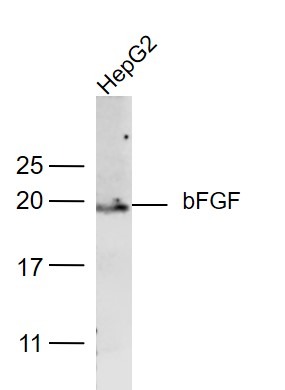Shopping Cart
Remove All Your shopping cart is currently empty
Your shopping cart is currently empty
Anti-FGF-2 Polyclonal Antibody is a Rabbit antibody targeting FGF-2. Anti-FGF-2 Polyclonal Antibody can be used in FCM,WB.
| Pack Size | Price | USA Warehouse | Global Warehouse | Quantity |
|---|---|---|---|---|
| 50 μL | $222 | 7-10 days | 7-10 days | |
| 100 μL | $373 | 7-10 days | 7-10 days | |
| 200 μL | $528 | 7-10 days | 7-10 days |
| Description | Anti-FGF-2 Polyclonal Antibody is a Rabbit antibody targeting FGF-2. Anti-FGF-2 Polyclonal Antibody can be used in FCM,WB. |
| Synonyms | HBGF-2, fibroblast growth factor 2 (basic), FGFB, FGF-2, BFGF |
| Ig Type | IgG |
| Reactivity | Human,Mouse (predicted:Rat,Chicken,Cow,Rabbit,Sheep) |
| Verified Activity | 1. Sample: HepG2 (Human) Cell Lysate at 30 μg Primary: Anti-bFGF (TMAB-00669) at 1/500 dilution Secondary: IRDye800CW Goat Anti-Rabbit IgG at 1/20000 dilution Predicted band size: 18 kDa Observed band size: 18 kDa 2. Blank control (Black line): Molt4 (Black). Primary Antibody (green line): Rabbit Anti-bFGF antibody (TMAB-00669) Dilution: 1 μg/10^6 cells; Isotype Control Antibody (orange line): Rabbit IgG. Secondary Antibody (white blue line): Goat anti-rabbit IgG-AF647 Dilution: 1 μg/test. Protocol The cells were fixed with 4% PFA (10 min at room temperature) and then permeabilized with 90% ice-cold methanol for 20 min at room temperature. The cells were then incubated in 5% BSA to block non-specific protein-protein interactions for 30 min at room temperature. Cells stained with Primary Antibody for 30 min at room temperature. The secondary antibody used for 40 min at room temperature.   |
| Application | |
| Recommended Dose | WB: 1:500-2000; FCM: 1μg/Test |
| Antibody Type | Polyclonal |
| Host Species | Rabbit |
| Subcellular Localization | Secreted. Nucleus. Note=Exported from cells by an endoplasmic reticulum (ER)/Golgi-independent mechanism. Unconventional secretion of FGF2 occurs by direct translocation across the plasma membrane. Binding of exogenous FGF2 to FGFR facilitates endocytosis followed by translocation of FGF2 across endosomal membrane into the cytosol. Nuclear import from the cytosol requires the classical nuclear import machinery, involving proteins KPNA1 and KPNB1, as well as CEP57. |
| Tissue Specificity | Expressed in granulosa and cumulus cells. Expressed in hepatocellular carcinoma cells, but not in non-cancerous liver tissue. |
| Construction | Polyclonal Antibody |
| Purification | Protein A purified |
| Appearance | Liquid |
| Formulation | 0.01M TBS (pH7.4) with 1% BSA, 0.02% Proclin300 and 50% Glycerol. |
| Concentration | 1 mg/mL |
| Research Background | The protein encoded by this gene is a member of the fibroblast growth factor (FGF) family. FGF family members bind heparin and possess broad mitogenic and angiogenic activities. This protein has been implicated in diverse biological processes, such as limb and nervous system development, wound healing, and tumor growth. The mRNA for this gene contains multiple polyadenylation sites, and is alternatively translated from non-AUG (CUG) and AUG initiation codons, resulting in five different isoforms with distinct properties. The CUG-initiated isoforms are localized in the nucleus and are responsible for the intracrine effect, whereas, the AUG-initiated form is mostly cytosolic and is responsible for the paracrine and autocrine effects of this FGF. [provided by RefSeq, Jul 2008]. |
| Immunogen | KLH conjugated synthetic peptide: human bFGF |
| Antigen Species | Human |
| Gene Name | FGF2 |
| Gene ID | |
| Protein Name | Fibroblast growth factor 2 |
| Uniprot ID | |
| Biology Area | FGF,Angiogenic growth factors,FGF,Kidney development,Neurogenesis,FGF,Extracellular |
| Function | Plays an important role in the regulation of cell survival, cell division, angiogenesis, cell differentiation and cell migration. Functions as potent mitogen in vitro. |
| Molecular Weight | Theoretical: 18 kDa. |
| Stability & Storage | Store at -20°C or -80°C for 12 months. Avoid repeated freeze-thaw cycles. |
| Transport | Shipping with blue ice. |
| Size | Quantity | Unit Price | Amount | Operation |
|---|

Copyright © 2015-2025 TargetMol Chemicals Inc. All Rights Reserved.